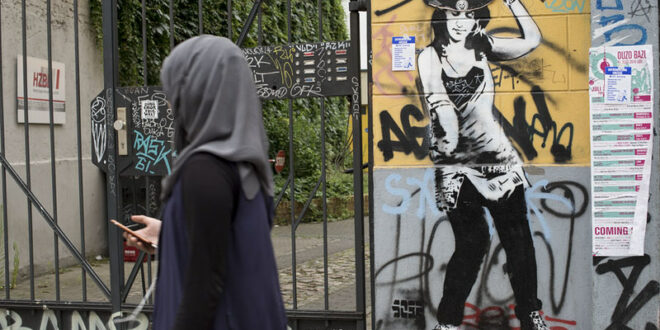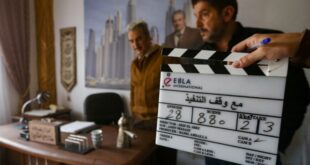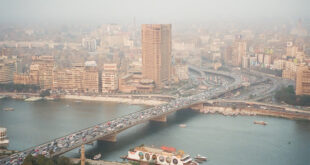Issue 36, Summer/Fall 2023
https://doi.org/10.70090/SK23AWRA
Dr. Sahar Khamis interviewed Dr. Nevine El-Nossery regarding her new book titled Arab Women’s Revolutionary Art: Between Singularities and Multitudes, which explore the ways women in the contemporary MENA region (Middle East and North Africa) have re-imagined revolutionary discourses—through creativity and collective action—as a means of resistance.
Sahar: Please provide a brief synopsis of this book and its most important themes.
Nevine: In the aftermath of the transformative uprisings that shook the Arab world twelve years ago, we find ourselves standing at a critical juncture. Dictatorships endure, while the elusive dream of establishing democracy lingers on. Yet these uprisings stand as a poignant testament to the formidable potential of collective action by offering tantalizing glimpses of a society rooted in political democracy, personal freedom, and social justice.
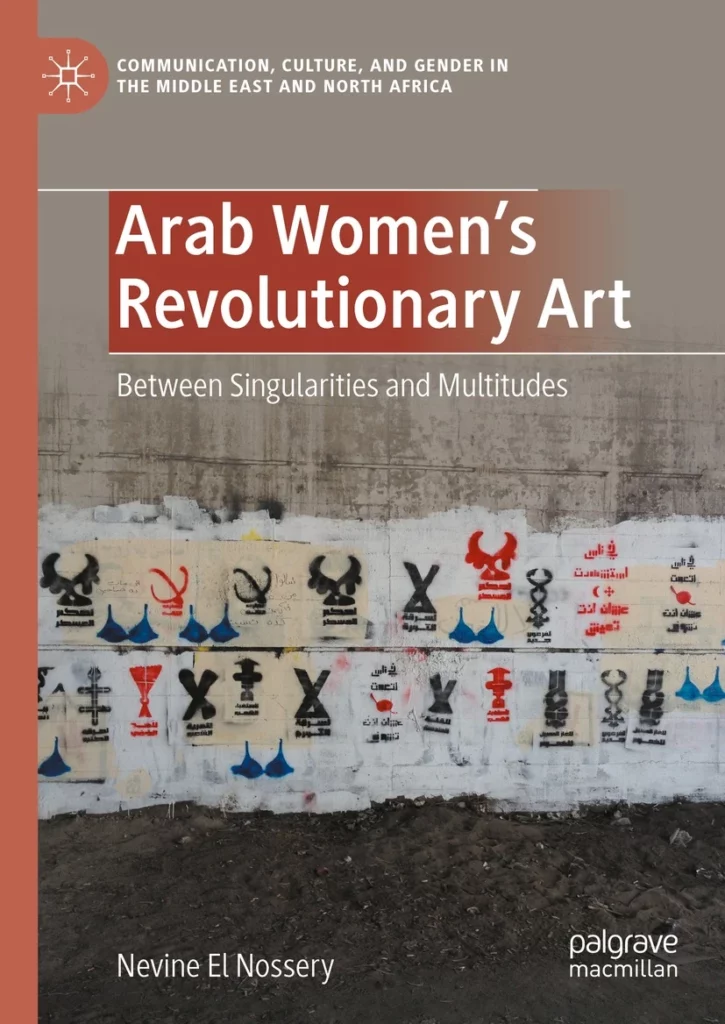
The central argument of my book, Arab Women's Revolutionary Art: Between Singularities and Multitudes contends that although the Arab uprisings may not have ushered in substantive socio-political change, they undeniably created an environment increasingly conducive to women's engagement in collective action and the public sphere. My book delves into how women in the MENA region, during recent periods of political turmoil, have enriched the intellectual and cultural discourse on revolution by harnessing creativity as a dynamic tool for resistance, contention, and transformation. Specifically, the book explores unconventional forms of artistic expression, which encompasses a diverse array of mediums such as graffiti, street performance, photography, photo-texts, and comics.
The key questions addressed are:
- What role does art play within these nascent revolutionary landscapes?
- Must art be overtly political to galvanize the public against oppression and injustice, or can it retain its purely abstract, aesthetic essence?
- What happens when art must operate clandestinely to evade government suppression, thereby giving rise to underground solidarity networks?
At its core, the book passionately contends the Arab uprisings birthed what could be aptly labelled a parallel artistic revolution, which comprises an underground and interstitial resurgence of art led by women. This artistic awakening has yielded ingenious methods for mobilizing popular consciousness, fueling resistance against oppressive regimes, and exemplifying what Hamid Dabashi astutely characterizes as "delayed defiance." Women, now more resolute than ever, boldly confront once-taboo subjects and employ innovative, and often unconventional, artistic forms. Despite these novel iterations, it is vital to recognize that female artists were not apolitical before the Arab Revolutions. Instead, the book illuminates how certain historical events and challenges precipitated the politicization of artists and audiences. This transformative wave reverberates through the fabric of societal, political, economic, and cultural relationships on a global scale.
Sahar: In your opinion, what are the two most important takeaways for readers?
Nevine: Within this book, I elucidate how the artistic creations that emerge from women in the post-revolutionary era possess a distinctiveness all their own, as they diverge even from the expressions of their male counterparts. It's crucial to note, this examination avoids essentialist viewpoints or an oversimplified comparative perspective. On one hand, I contend these artistic expressions are underpinned by a deliberate embrace of social media and cutting-edge technologies, while facilitating a capacity to reach to wider audiences. The methods and techniques employed by these remarkable women have diversified significantly. They encompass the realms of performative art, documentary filmmaking, social activism, community-driven initiatives, artist-led political movements, and collective artistic endeavors, as well as an extensive utilization of the internet and social media platforms. In essence, these artists reclaim public spaces, transforming them into participatory platforms where the audience engages with art and becomes an integral part of the creative process. On the other hand, I posit these women are inherently influenced by a transnational perspective, albeit indirectly. This standpoint enables them to cultivate fresh personal and social dynamics. By resisting confinement to the label of "local artists," these women effectively dismantle the confines of national borders. They do so in a concerted effort to connect with broader audiences—both locally and globally—by harnessing the power of globalized media, such as social networking platforms, blogs, and the translation of their work. In Egypt, North Africa, throughout the Middle East, and even beyond these geographical boundaries, women are progressively casting themselves as global citizens. This transformation signals a reconfiguration of transnational power structures, which give rise to new constellations of liberation that are guided by the boundless expanses of human imagination.
Sahar: What motivated you to write this book?
Nevine: My motivation was deeply rooted in the transformative events that unfolded during the Arab uprisings in 2011. Throughout this period, I was repeatedly asked to offer insights regarding the role of women in these revolutions. My longstanding interest in exploring women's creativity in my scholarly pursuits compelled me to embark on a journey of documenting women's active involvement in the Arab uprising, which I coined in my book as revolutionary art.
Sahar: What does this book add to the existing literature on the Arab Spring, particularly as it relates to the role of women in these movements?
Nevine: This book makes a significant and unique contribution to the existing literature on the Arab Spring through a fresh perspective that goes beyond conventional treatments of this period of upheaval and, in particular, the roles of Arab women within these movements.
First and foremost, it adopts a comparative and interdisciplinary approach that sets it apart. Rather than confining itself to a narrow chronological or geographical focus, the book encompasses a broad spectrum of interdisciplinary approaches, including literary, cultural, and visual studies, as well as feminist studies, media studies, and postcolonial studies. It draws inspiration from the works of prominent thinkers who have explored the intricate intersections between art and politics. These include Hannah Arendt, Pierre Bourdieu, Jacques Derrida, Antonio Negri, Jacques Rancière, and Edward Said, among others.
Each of the six chapters in the book delves into a specific creative domain deeply intertwined with women's engagement, which are the result of nearly five years of extensive research, documentation, and on-the-ground interviews conducted in Arabic and French within Egypt, Tunisia, and Morocco. The book's timeline extends from the immediate aftermath of the Jasmine Revolution in Tunisia through the occupation of Tahrir Square in Egypt and continues into the present day. This extended timeframe provides a comprehensive understanding of the nature, significance, and evolving role of these artistic expressions, which are situated within the context of the longue durée. Rather than viewing revolution as a series of isolated events with clear-cut beginnings and endings, this book takes a more holistic perspective by conceptualizing revolution as an ongoing process. It emphasizes the concept of revolution as being connected to the verb to revolve, which signifies a continual movement of change and transformation. This perspective aligns with enduring changes in human nature and the diverse social and cultural practices that emerge as a result. In essence, this book serves as a groundbreaking contribution that transcends the confines of current scholarship on the Arab Spring. It embarks on a nuanced and all-encompassing journey by delving deeply into the intricate interplay between art, politics, and the unwavering essence of revolution. Ultimately, the book endeavors to unveil the profound metamorphoses in human nature and the fabric of society that emerged in the aftermath of these epochal events.
Sahar: How is this book different from the others that examine Arab women's activism, before, during, and after the Arab Spring?
Nevine: While numerous books often overlook the crucial role played by women in the Arab uprisings, a select few have examined the multifaceted roles of Arab women. These studies examine Arab women as active participants, organizers, leaders, politicians, and unfortunately, as victims. They've also shed light on their contributions to the ongoing processes of change, democratization, gender legislation, gender activism. Other books examine women's roles within Islamist movements, state feminism, women's impact on the political economy, and the advancement of women's rights amidst a complex backdrop of political transitions. These existing studies vividly illustrate the extent to which women stood at the forefront of collective actions and engaged in various civic and militant movements throughout the Middle East and North Africa during this revolutionary period. Drawing from and building upon this scholarship, my book takes a significant step forward in the academic discourse. It advances the theoretical debate by critically examining the concept of art through a gendered perspective, particularly in relation to the dynamic political and social transformations that unfolded during the Arab Spring. It's worth noting that relatively few books have focused on the creative contributions of women in the Arab revolutions. My book strives to address this gap, offering a comparative perspective that encompasses multiple countries. It seeks to answer a pivotal question, specifically how did women challenge, subvert, and redefine established artistic norms in the crucible of revolution and resistance? This question serves as the guiding force and serves to unearth compelling and often overlooked narratives involving these remarkable women artists.
Sahar: Can you describe your research process? Further, what drew you to certain pieces of art, as well as particular artists?
Nevine: Embarking on a comparative journey, my book draws upon a diverse spectrum of interdisciplinary approaches, which encompass literary, cultural, visual, feminist, media, and postcolonial studies. To facilitate a more profound understanding of the intricate interplay between the textual and the visual, as well as the nuanced choices of artistic media, the book is thoughtfully partitioned into three distinct sections, which are Visualizing the Revolution, Performing the Revolution, and Writing the Revolution.
The focus of the research comprises a select group of accomplished women artists, which prominently includes Bahia Shehab, Héla Ammar, Dora Latiri, Zainab Fasiki, and Kaouther Adimi. However, it's important to underscore that my exploration endeavors to also encompass a comprehensive exploration of other women artists hailing from the Middle East and North Africa (MENA) region. The criteria guiding these selections were the profound and impactful contributions of these artists to the discourse on revolution through their artistic expressions.
Throughout this scholarly exploration, I meticulously examine a rich tapestry of artistic creations originating from various revolutionary periods, locales, and linguistic backgrounds, with a particular emphasis on Arabic and French. By delving into the innovative approaches these artists employ, my book uncovers alternative epistemologies and serves as an archive of defiance, showcasing their capacity for radical and creative modes of expression.
Sahar: What was one thing that surprised you during your research and writing process?
Nevine: During my research and writing process, what most surprised and inspired me was the resilience and creativity displayed by women artists in the MENA region during and after the Arab uprisings. Despite limited political and economic change that resulted from the uprisings, I was amazed by the exponential growth of non-conventional artistic expressions. Graffiti, street performances, photography, photo-texts, comics, and other inventive forms of art flourished. These art forms became powerful tools to convey messages of resistance and contestation. Moreover, the role of social media in facilitating and amplifying these artistic expressions was truly surprising. Social media platforms provided an instantaneous and informal means of disseminating art and ideas, capturing the sense of immediacy inherent in the revolutionary environment. Overall, I was deeply inspired by women artists harnessing their creativity to confront political and societal challenges, adapt to changing circumstances, and contribute to a broader discourse on revolution and social change. Their ability to innovate and adapt their art forms, while using social media to reach audiences worldwide, exemplifies the enduring power of artistic expression as a force for change and resilience.
Sahar: How does this research help inform your teaching, and vice-versa?
Nevine: My scholarship, teaching, and foremost my identity is shaped by concepts like diversity and intersectionality. Through my research, I am interested in examining the various interstitial spaces where languages, genres, and viewpoints intertwine, which reflect the (in)balance of power that can exist between societies, states, and people in postcolonial settings. I bring these ideas into the classroom, which offers a space where all differences can be discovered, excavated, and come to the forefront. For the last fifteen years at UW-Madison, I bring my students into the worlds of Francophone and Arabic literatures and cultures. The material I teach brings students into unfamiliar places and shows them different ways of living and even dreaming. These experiences, both distinct from their own and yet similar, enhance their ability to bridge cultures and go beyond trivial differences. But it also allows them to better understand and discern the world that surrounds us and to look at it anew with fresh eyes. Reading foreign works can expand their horizons of thinking and fill the void when answers are evasive. Further, it provides nuance to their perspectives, alters their views, and challenges the ideas they take for granted. In the end, my Wisconsin students will become global citizens who recognize and respect differences, rather than seek sameness.
Sahar: In hindsight, please mention one or two points you would have liked to add to this book, before its publication.
Nevine: First, a more extensive exploration of the impact of globalization on the evolving artistic landscape in the MENA region would have provided a deeper understanding of the dynamics at play. This could have shed light on how forces intersect with artistic expressions and the ways that artists navigate these challenges. Second, and although the book takes a comparative approach within the MENA region, it would have been insightful to include more global comparisons. How do the experiences and artistic expressions of Arab women during the Arab Spring compare to those of women in other regions during similar periods of political upheaval? Drawing parallels and contrasts with other global movements could have provided a richer context for understanding the impact of women's contributions.
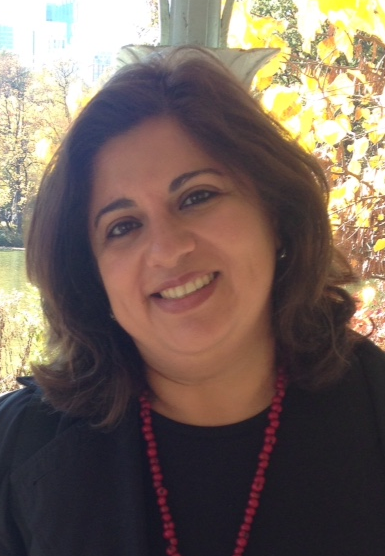
 Arab Media & Society The Arab Media Hub
Arab Media & Society The Arab Media Hub
